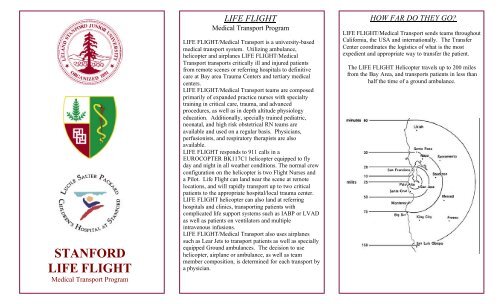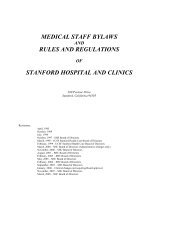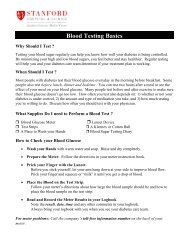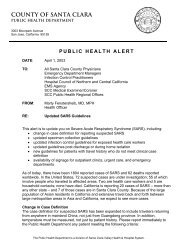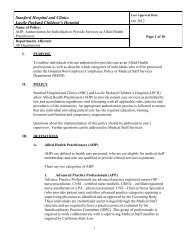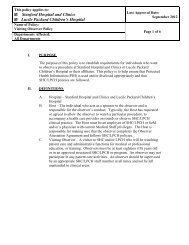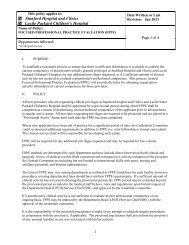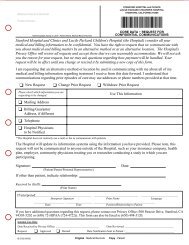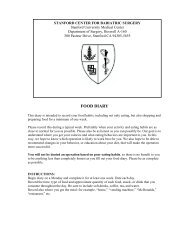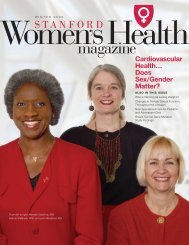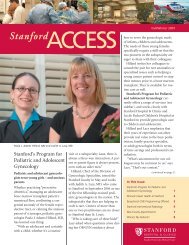Full Brochure of Stanford Life Flight Program using Acrobat
Full Brochure of Stanford Life Flight Program using Acrobat
Full Brochure of Stanford Life Flight Program using Acrobat
You also want an ePaper? Increase the reach of your titles
YUMPU automatically turns print PDFs into web optimized ePapers that Google loves.
STANFORD<br />
LIFE FLIGHT<br />
Medical Transport <strong>Program</strong><br />
LIFE FLIGHT<br />
Medical Transport <strong>Program</strong><br />
LIFE FLIGHT/Medical Transport is a university-based<br />
medical transport system. Utilizing ambulance,<br />
helicopter and airplanes LIFE FLIGHT/Medical<br />
Transport transports critically ill and injured patients<br />
from remote scenes or referring hospitals to definitive<br />
care at Bay area Trauma Centers and tertiary medical<br />
centers.<br />
LIFE FLIGHT/Medical Transport teams are composed<br />
primarily <strong>of</strong> expanded practice nurses with specialty<br />
training in critical care, trauma, and advanced<br />
procedures, as well as in depth altitude physiology<br />
education. Additionally, specially trained pediatric,<br />
neonatal, and high risk obstetrical RN teams are<br />
available and used on a regular basis. Physicians,<br />
perfusionists, and respiratory therapists are also<br />
available.<br />
LIFE FLIGHT responds to 911 calls in a<br />
EUROCOPTER BK117C1 helicopter equipped to fly<br />
day and night in all weather conditions. The normal crew<br />
configuration on the helicopter is two <strong>Flight</strong> Nurses and<br />
a Pilot. <strong>Life</strong> <strong>Flight</strong> can land near the scene at remote<br />
locations, and will rapidly transport up to two critical<br />
patients to the appropriate hospital/local trauma center.<br />
LIFE FLIGHT helicopter can also land at referring<br />
hospitals and clinics, transporting patients with<br />
complicated life support systems such as IABP or LVAD<br />
as well as patients on ventilators and multiple<br />
intravenous infusions.<br />
LIFE FLIGHT/Medical Transport also uses airplanes<br />
such as Lear Jets to transport patients as well as specially<br />
equipped Ground ambulances. The decision to use<br />
helicopter, airplane or ambulance, as well as team<br />
member composition, is determined for each transport by<br />
a physician.<br />
HOW FAR DO THEY GO?<br />
LIFE FLIGHT/Medical Transport sends teams throughout<br />
California, the USA and internationally. The Transfer<br />
Center coordinates the logistics <strong>of</strong> what is the most<br />
expedient and appropriate way to transfer the patient.<br />
The LIFE FLIGHT Helicopter travels up to 200 miles<br />
from the Bay Area, and transports patients in less than<br />
half the time <strong>of</strong> a ground ambulance.
ONE CALL IS ALL IT TAKES<br />
For Physician to Physician consults or to transport a patient from<br />
your hospital or facility, just call the Transfer Center. The<br />
Transfer Center is staffed 24 hours a day, 7 days a week to help<br />
you provide the best care for your patient.<br />
Our specially trained communication specialists will take your call,<br />
put you in contact with the appropriate specialist, and take all the<br />
necessary steps to get the patient admitted if that is what is needed.<br />
In addition, they will consult with the Medical Control Physician to<br />
determine how best to transport the patient, whether it is by<br />
Ambulance, Airplane, or Helicopter.<br />
TRANSFER CENTER<br />
1-800-800 1551<br />
To transport a patient from the location <strong>of</strong> an accident, or for<br />
remote medical emergencies one call to the LIFE FLIGHT<br />
Dispatch center will get the helicopter airborne within 6 minutes.<br />
Information to give the dispatcher includes:<br />
-Location <strong>of</strong> incident or landing zone.<br />
-Radio frequency for the LIFE FLIGHT team to contact the<br />
personnel on the ground.<br />
-Number <strong>of</strong> patients for LIFE FLIGHT.<br />
LIFE FLIGHT<br />
1-800-321-STAT<br />
To schedule al visit from one <strong>of</strong> the LIFE FLIGHT / Medical<br />
Transport personnel for inservices regarding hospital transfers or<br />
scene transports, or for more information, call 650-723 5578<br />
STANFORD CONTACT NUMBERS<br />
DISPATCH 1-800-321 STAT<br />
OR 1-800-321 7828<br />
TRANSFER CENTER<br />
INTER FACILITY 1-800-800 1551<br />
AVIATION RADIO 130.05 MHz<br />
OR<br />
CALCORD<br />
<strong>Life</strong> <strong>Flight</strong> “Fly along” program 650-725-4835.<br />
STANFORD LIFE FLIGHT<br />
LANDING ZONE REQUIREMENTS<br />
LZ / FLIGHT DETAILS<br />
a. 75’ x 75’ DAY, 125’ x 125’ NIGHT<br />
b. WET DOWN dusty areas prone to “brown out” conditions.<br />
c. NO overhead OR approach obstructions , approach path 8:1<br />
d. FLAT LZ w/ MAX 5 degree slope.<br />
e. 100 ft. from Emergency vehicles , patient, or buildings.<br />
f. 200 ft. from non-emergency personnel (on-lookers etc.)<br />
g. 500 ft. from horses and other domestic livestock.<br />
h. NEVER downwind from HAZMAT AREA<br />
i. 1000 ft. From HAZMAT AREA.<br />
j. Cement, asphalt, grass, or hard packed dirt are preferred surfaces.<br />
k. No loose debris or loosely packed surfaces.<br />
j. NOTIFY Crew <strong>of</strong> any patients who are: Combative ,in Police Custody<br />
or Contaminated by any HAZMAT, including gasoline.<br />
DAYLIGHT OPERATIONS<br />
a. WET DOWN dusty areas prone to “brown out” conditions.<br />
B. INFORM PILOT PRIOR TO ARRIVAL OF ANYNEARBY HAZARDS<br />
e.g. trees, power and telephone lines, antennas, traffic, LZ surface and<br />
markings.<br />
NIGHT OPERATIONS<br />
a. WET DOWN dusty areas prone to “brown out” conditions.<br />
b. BE MORE DESCRIPTIVE <strong>of</strong> the LZ and hazards.<br />
c. MARK LZ clearly with Strobes in a square pattern,<br />
Bean bag lights, or vehicle lights crisscrossed at the landing spot<br />
d. NEVER point lights towards the aircraft.<br />
e. Turn <strong>of</strong>f headlights that point at LZ or aircraft after landing.<br />
LANDING<br />
You may stand with your back to the wind arms raised<br />
in the LZ to mark the intended spot <strong>of</strong> Landing, but EVERYONE must remain<br />
well clear <strong>of</strong> the LZ once the aircraft has began it’s final approach. Ensure<br />
that anyone near the landing helicopter has turned away or is wearing<br />
protective goggles.<br />
SAFETY AT THE LZ<br />
a. Secure loose objects, control crowds, control traffic.<br />
b. Remain on the radio, be vigilant for hazards.<br />
c. NEVER approach or depart the helicopter unless cleared to<br />
do so by a crewmember.<br />
d. NEVER approach the rear (tail rotor) or go around the<br />
back<strong>of</strong> the aircraft.<br />
e. Keep all vehicle traffic out <strong>of</strong> the LZ.<br />
f. NO SMOKING within 100 ft.<br />
g. Stay on the downslope side <strong>of</strong> the helicopter.<br />
NEVER WALK DOWN to a helicopter.<br />
h. NO loose hats, caps, or free clothing.<br />
i. NEVER Raise anything above head height<br />
j. If you drop or lose something near the helicopter, do not<br />
retrieve it, Notify a crewmember and they will retrieve it<br />
for you.<br />
k. Consider alternate LZ locations in case the pilot deems the<br />
current LZ unsafe or weather conditions dictate relocation.<br />
REMAIN ON LZ FREQUENCY until two minutes after departure


